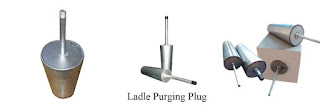What causes tundish nozzle clogging
Tundish nozzle clogging introduction:
Clogging of the tundish nozzle is a major castability problem in continuous casting of steel for several reasons.Firstly, clogging increases the frequency of operation disruptions to change nozzles or tundishes or even to stop casting. These extra transitions increase operating cost, decrease productivity, and lower quality.
Secondly, clogging can lead directly to a variety of quality problems. Clogs change the nozzle flow pattern and jet characteristics exiting the ports, which can disrupt flow in the mold, leading to surface defects in the steel product and even breakouts. Dislodged clogs also disturb the flow and either become trapped in the steel or change the flux composition, leading to defects in either case. Quality problems also arise from the mold level transients which occur as the flow control device compensates for the clogging.
Clogging is a complex problem which has received a great deal of past study. Two comprehensive reviews of current understanding are given, who recently summarized the many different causes and remedies with practical operation guidelines. This paper provides a summary of the formation mechanisms, detection methods, and prevention of tundish nozzle clogging.
Types OF Tundish Nozzle Clogging
Tundish nozzle clogging problems take many different forms, and can occur anywhere inside the nozzle, including the upper well, bore, and ports. They are classified here into four different types according to their formation mechanism: the transport of oxides present in the steel to the nozzle wall, air aspiration into the nozzle, chemical reaction between the nozzle refractory and the steel, and steel solidified in the nozzle. In practice, a given nozzle clog is often a combination of two or more of these types, and its exact cause(s) can be difficult to identify.1.Transport of oxides present in the steel
2.Air aspiration into the nozzle
3.Chemical reaction between nozzle refractory and steel
4.Steel solidified in the nozzle
Tundish Nozzle Clog Identification:
A score of different practices are helpful to minimize clogging. The remedies may be classified as inclusion prevention, inclusion modification (Ca treatment), nozzle material / design improvement, and argon injection .The best remedial action depends on the steel grade and exact cause of the specific clogging problem being considered. Thus, the first step is to identify the clogging cause by monitoring important parameters
During casting and by visual, microscopic, and chemical examination of clogged material.
A lot can be learned about the cause of clogging from careful visual inspection and analysis of the clog itself. An example clog in the upper tundish nozzle above the slide gate of a typical slab-casting operation. Clogs above the slide gate, such as thisone, are particularly disruptive because they require a tundish change.
This particular clog was retrieved after casting five 250 ton heats of 0.0023%C steel containing 0.039% acid soluable.
Wanhao is a manufacturer who is specialized in designing various kinds of furnace and making refractory products for electric furnace, ladle, tundish, blast furnace, AOD furnace, IF furnace, etc.
Article Source:What causes tundish nozzle clogging
More Refractory Products:https://www.wanhaorefractory.com/en/product.html
Website:https://www.wanhaorefractory.com/


评论
发表评论